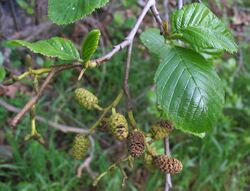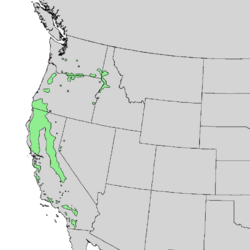Biology:Alnus rhombifolia
| White alder | |
|---|---|

| |
| Foliage and fruit | |
| Scientific classification | |
| Kingdom: | Plantae |
| Clade: | Tracheophytes |
| Clade: | Angiosperms |
| Clade: | Eudicots |
| Clade: | Rosids |
| Order: | Fagales |
| Family: | Betulaceae |
| Genus: | Alnus |
| Subgenus: | Alnus subg. Alnus |
| Species: | A. rhombifolia
|
| Binomial name | |
| Alnus rhombifolia | |

| |
| Natural range of Alnus rhombifolia | |
Alnus rhombifolia, the white alder, is an alder tree native to western North America, from British Columbia and Washington east to western Montana, southeast to the Sierra Nevada, and south through the Peninsular Ranges and Colorado Desert oases in Southern California .[2] It occurs in riparian zone habitats at an altitudes range of 100–2,400 metres (330–7,870 ft).[3][4] While not reported in northern Baja California, it has been predicted on the basis of its climatic adaptation to occur there also.[3] Alnus rhombifolia is primarily found in the chaparral and woodlands, montane, and temperate forests ecoregions.[2]
Description
Alnus rhombifolia is a medium-sized deciduous tree growing to 15–25 metres (49–82 ft) (rarely to 35 metres (115 ft)) tall, with pale gray bark, smooth on young trees, becoming scaly on old trees. The leaves are alternate, rhombic to narrow elliptic, 4–10 centimetres (1.6–3.9 in) long and 2–5 centimetres (0.79–1.97 in) broad, with a finely serrated margin and a rounded to acute apex; they are thinly hairy below.[5]
The flowers are produced in catkins. The male catkins are pendulous, slender, 3–10 centimetres (1.2–3.9 in) long, yellowish, and produced in clusters of two to seven; pollination is in early spring, before the leaves emerge. The female catkins are ovoid, when mature in autumn 10–22 millimetres (0.39–0.87 in) long and 7–10 millimetres (0.28–0.39 in) broad, on a 1–10 millimetres (0.039–0.394 in) stem, superficially resembling a small conifer cone.[5] The small winged seeds disperse through the winter, leaving the old woody, blackish 'cones' on the tree for up to a year after.[2][3][6]
The white alder is closely related to the red alder (Alnus rubra), differing in the leaf margins being flat, not curled under. Like other alders, it is able to fix nitrogen, and tolerates infertile soils.[6]
Medicinal use
Some Plateau Indian tribes use white alder for female health treatment needs.[7]
References
- ↑ Stritch, L. (2014). "Alnus rhombifolia". The IUCN Red List of Threatened Species (IUCN) 208: e.T194648A2355642.. doi:10.2305/IUCN.UK.2014-3.RLTS.T194648A2355642.en.
- ↑ 2.0 2.1 2.2 "UC/JEPS: Jepson Manual treatment for ALNUS rhombifolia". http://ucjeps.berkeley.edu/cgi-bin/get_JM_treatment.pl?Alnus+rhombifolia.
- ↑ 3.0 3.1 3.2 Flora of North America: Alnus rhombifolia
- ↑ {{citation | mode = cs1 | title = Alnus rhombifolia | work = Germplasm Resources Information Network (GRIN) | url = | publisher = [[Organization:Agricultural Research ServAgricultural Research Service (ARS), United States Department of Agriculture (USDA) | access-date = 22 December 2017 }}
- ↑ 5.0 5.1 http://calphotos.berkeley.edu/cgi/img_query?query_src=photos_index&where-lifeform=any&rel-taxon=contains&where-taxon=Alnus+rhombifolia&rel-namesoup=matchphrase&where-namesoup=&rel-location=matchphrase&where-location=&rel-county=eq&where-county=any&rel-state=eq&where-state=any&rel-country=eq&where-country=any&where-collectn=any&rel-photographer=contains&where-photographer=&rel-kwid=equals&where-kwid=&max_rows=24 calphoto . accessed 9/29/2010
- ↑ 6.0 6.1 Oregon State University: Alnus rhombifolia
- ↑ Hunn, Eugene S. (1990). Nch'i-Wana, "The Big River": Mid-Columbia Indians and Their Land. University of Washington Press. p. 351. ISBN 0-295-97119-3.
External links
- Jepson Manual treatment- Alnus rhombifolia
- USDA: Alnus rhombifolia - data and range maps
- Alnus rhombifolia - Photo gallery
Wikidata ☰ Q2666303 entry
 |


